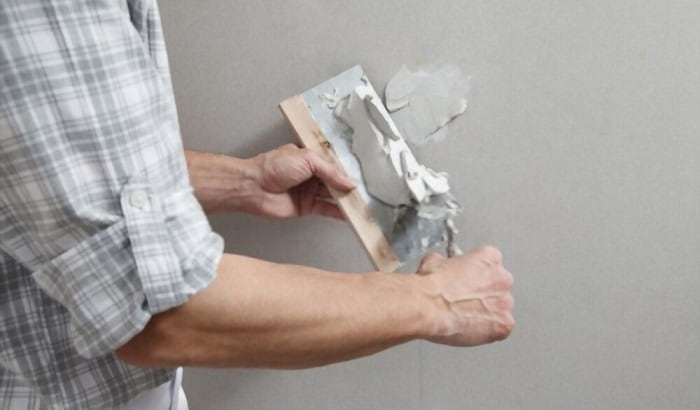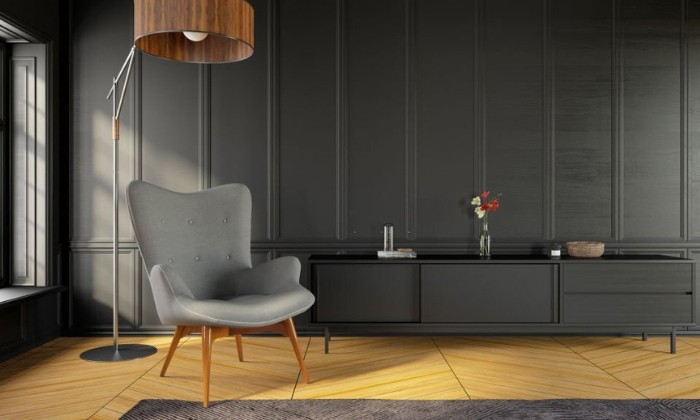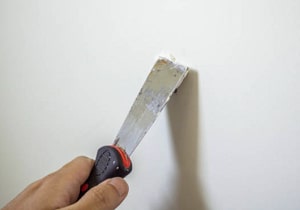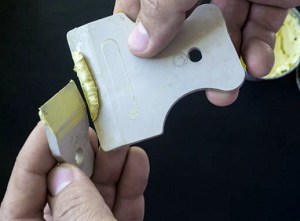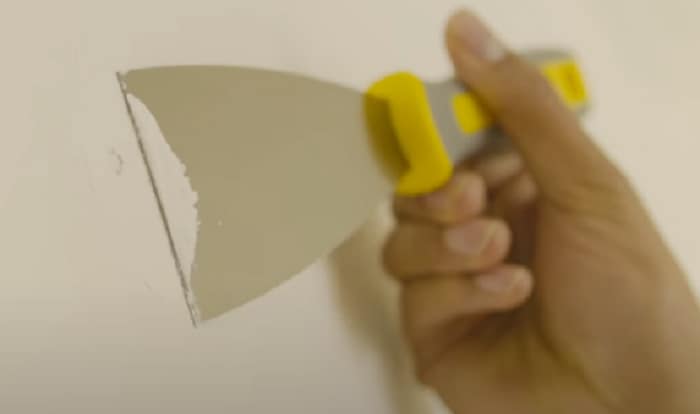While holes in the walls might not necessarily be an immediate cause of concern, they are still an unpleasant sight no one wants to see. No matter how minuscule, once you notice the cavity, it’s nearly impossible to ignore the ugly imperfection.
Of course, you can get a professional to help you with the situation. However, when the expected repair cost by an expert can rack up to half a grand, maybe it’s time to find creative ways to cover holes in the wall and address the issue yourself.
Table of Contents
Ingenious Ideas to Cover Holes in the Walls
1. Conceal with picture
One natural way to disguise holes is with picture frames. As photos naturally belong on walls, no one will think twice about their existence around your house. In fact, the addition of wall art will make your living space even more attractive.
It goes without saying that the picture should complement your decor scheme. For instance, homes with a minimalistic design should lean towards a large picture with neutral colors as the sole centerpiece.
A gallery display is also a fantastic way to hide holes in the wall. However, make sure that the collection follows a certain template and narrative. In addition, symmetry also shouldn’t be overlooked; otherwise, it’ll be a cluttered mess.
2. Hide behind furniture
When a hole appears too high up for you to naturally conceal with picture frames, a tall bookshelf will be a better solution. This works best when there’s already an existing case in your home, and all you need to do is rearrange the furniture.
A notable advantage of this solution is that it’s also one of the easiest floor tile cover-up ideas. Although it’ll take some time and labor to change the layout of a room to naturally cover a large hole, it at least will not cost you any extra money.
3. Hang tapestry
When you don’t have time to repair holes or rearrange furniture, hanging a tapestry would be the quickest fix. With the help of Velcro tape or adhesive hooks, you can put the decorative fabric up within a matter of mere minutes.
Aside from concealing the hollow spot, tapestries can also distract the eyes from other imperfections in the room, especially when used as a focal point. No one will notice a slightly messy table if they’re busy beholding the colors and texture of your wall decor.
4. Use draperies
Did you know that you can use draperies as a decorative cover for holes in walls? With this particular method, you can cover an entire surface, so I can imagine that this would be ideal for areas with several cracks and dents.
Compared to other ideas, hanging draperies can completely transform the look and feel of a room without painting or all-out renovation. So long as the fabric complements the interior scheme, it’ll be a fantastic addition to your decorative accessories.
5. Switch to bigger curtains
When a hole appears near your curtain, concealing it with a picture frame or tapestry won’t be feasible. As the position is close to the window, hanging anything within its vicinity will look awkward, if not downright suspicious.
In this scenario, switching to bigger curtains will offer a more natural look. No one will question what lies behind the drawn fabric. What’s more, small rooms will also appreciate how the bigger curtains give the illusion of space.
6. Put on wall panels
Here’s the good news: you can cover holes in ceramic tile without removing the old surface by installing wall panels directly on it. Even better, this method also works on humid areas like a bathroom wall, as long as the panels are waterproof.
Given how wall panels are available in many colors and styles, I’d say that they are worth considering for anyone in need of ideas for covering kitchen tiles.
Easy Ways to Fix Holes in the Wall
1. Rub in toothpaste
To deal with small holes, such as ones from nails, you can try using toothpaste. However, this will only work if the toothpaste’s hue is akin to your wall’s. Mixing food coloring with the product is a viable option, but it may take several tries to get a close match to the paint shade.
The downside of this method is that it doesn’t last long and thus may require continual re-application. To prolong the effect, you can mix the toothpaste with finely crushed aspirin, but I don’t imagine this as a permanent fix either.
In addition, note that toothpaste can’t fill anything larger than ¼ inch.
2. Mix baking soda and glue
While a paste consisting of baking soda and water will also work, I suggest substituting the latter with glue for a better effect. As glue consistency may vary, it’s hard to pin down the exact ratio, but you can just mix the ingredients until they form a thick paste.
As is the case with filling wall holes with household items, a mixture of baking soda and glue doesn’t hold up for long.
3. Use spackle
For a long-term solution that can fill holes both in the ceiling and the wall, go for spackle. Given how easy it is to apply spackle, I would personally recommend you try this out in the first place to avoid future hassle.
All you have to do is prep the surface by lightly rubbing it with 150-grit sandpaper. Then, fill the hole with the spackle paste. Once it dries, scrape and sand the wall until it’s even. Finally, apply a coat of paint over the filled hole to blend it with its surrounding.
4. Opt for patching plaster
It’ll be next to impossible to fix large holes with household items. Any holes larger than a golf ball will require patching plaster, which is suitable for both dry and plaster walls.
- Gently remove all the loose debris from the cavity in the wall.
- Coat sealant over the horizontal slats and their surrounding area to improve the adhesive properties.
- Allow the sealant to dry – this will take only a couple of minutes.
- Using a trowel, slather a generous amount of patching plaster mixture over the surface that needs repair. Go along the hole’s edge to seal it properly without having the compound wedge between the slats.
- Smear away any excess plaster with the trowel, then allow it to dry.
- Apply another paper-thin coat on the surface with the hole and leave it alone for 24 hours.
- Smooth the surface with low-grade sandpaper, then repeat the motion with a high-grade one.
- Paint the wall.
5. Apply auto-body filler
Although auto body filler is formulated for vehicle repair, it’s also an amazing tile hole filler. Fortunately, filling cavities in porcelain tile with this putty isn’t complicated either. With a clean surface free of debris, you’re already halfway to fixing your wall.
Mix the filler according to the instructions on the label. You can add a few drops of paint the same color as your wall.
Once you’re satisfied with the consistency, smear the mixture onto the surface to fill holes in the tile. Sand away the excess for a smooth surface when it dries.
6. Fill with caulk
Applying auto body filler can be an unnecessary hassle sometimes, especially if the holes in tiles are smaller than 0.5 inch. In this case, I’d opt for caulk as a quick and easy solution, as it’ll only take a few minutes.
To deal with the problem, all you have to do is fill holes in the tile with caulk and smear away the excess. Afterward, leave the caulk alone to dry; there’s nothing else you need to do.
FAQs
What is the fastest way to hide a hole in a wall?
The fastest and most economical way to hide a hole in a wall would be to fill it with toothpaste. It will take you only a few minutes at most. However, this will also be a temporary fix that might need reapplication soon.
Another quick solution you can consider is hanging a tapestry. Using simple Velcro tape, you can have the fabric up without having to drill more holes into the wall.
Similarly, consider hanging picture frames with adhesive strips for quick and damage-free mounting.
What household items can fix a hole in the wall?
Among various household items, a mixture of toothpaste and aspirin is the best at filling a wall hole. A thick paste of glue and baking soda will also be sufficient to fix the punctured surface, as it will harden once it dries.
Conclusion
By now, you’ve learned all the creative ways to cover holes in the wall. In short, you can either conceal the defects with something else, or you can try to fill the cavities entirely. As for which option to choose between the two, it depends on the severity of the hole.
I hope I’ve answered all of your questions. If there’s anything else you wish to know, don’t hesitate to contact us.

Hi, I am Roseanne Jones, an aspiring home designer that wants to make you feel more at home with your new house.With nearly five years of redecorating old residents and arranging new ones, I am confident that I can give you the best advice on your lovely place.


